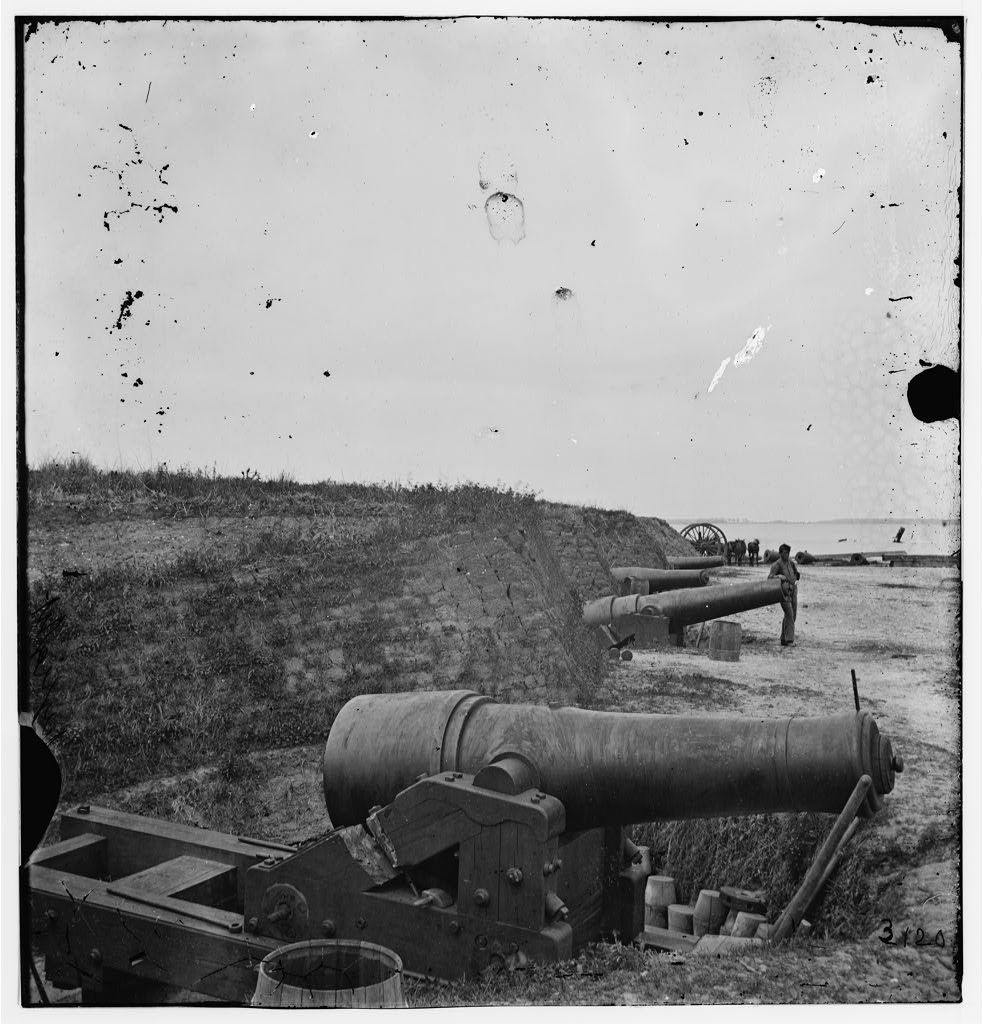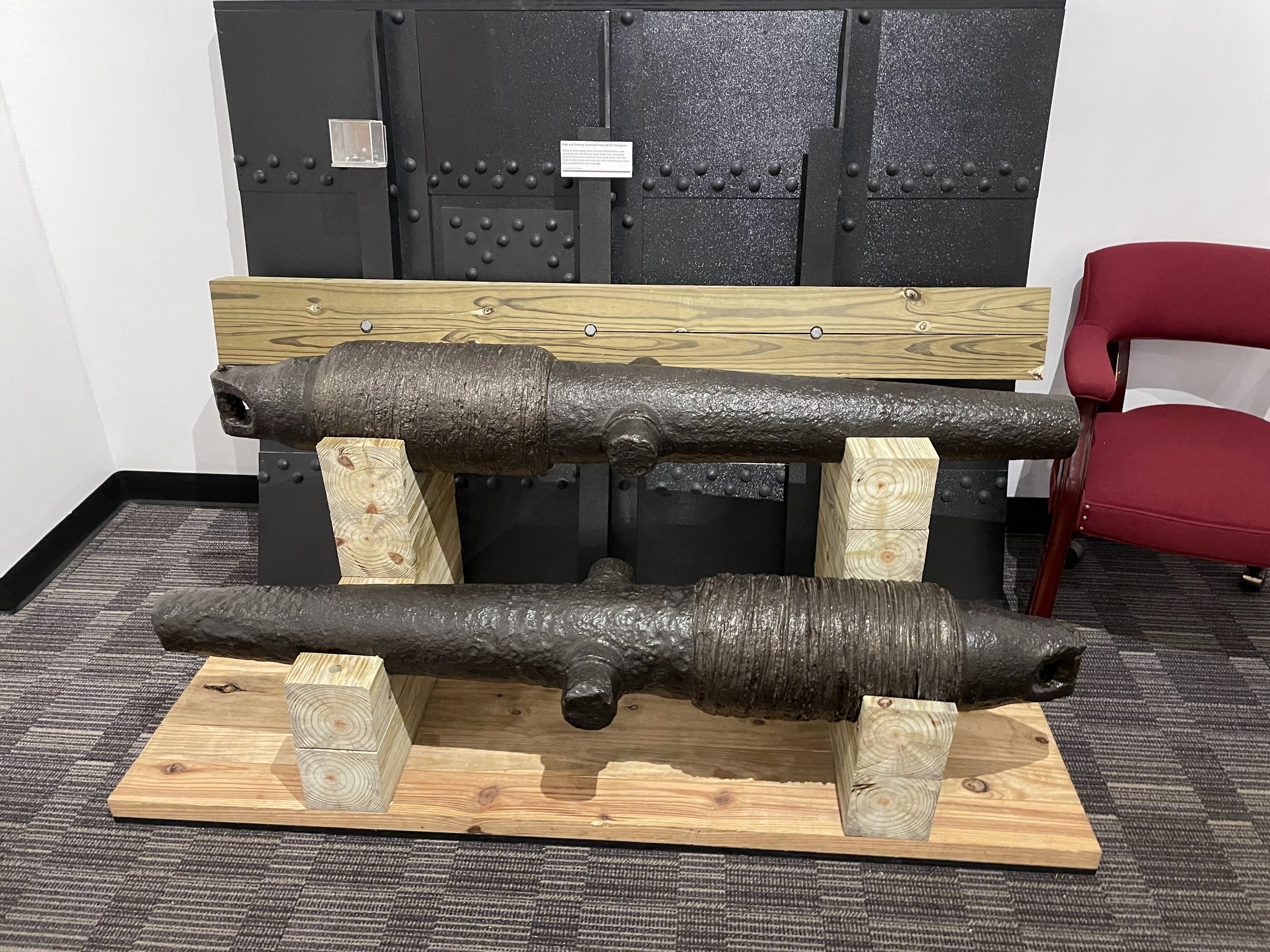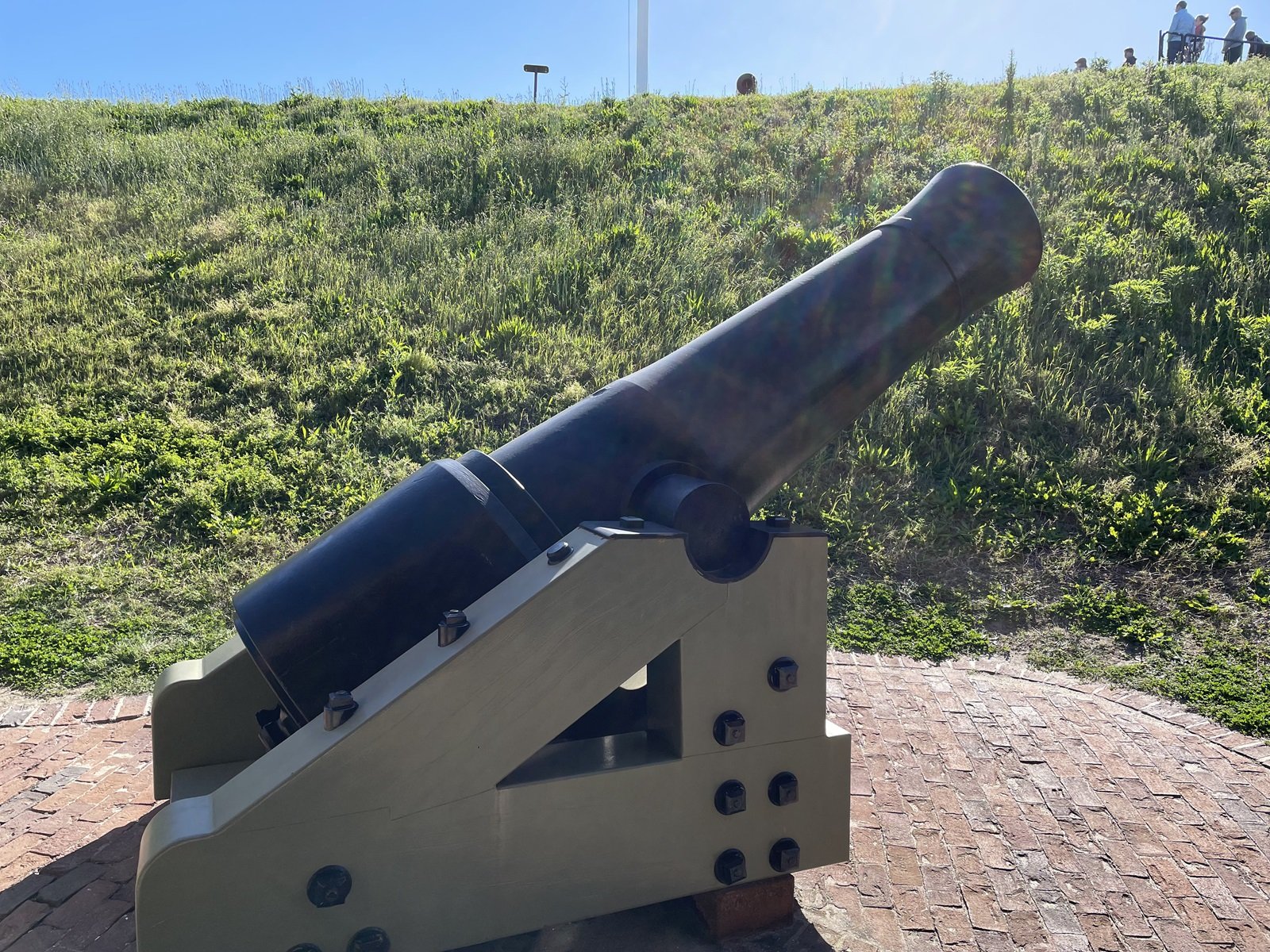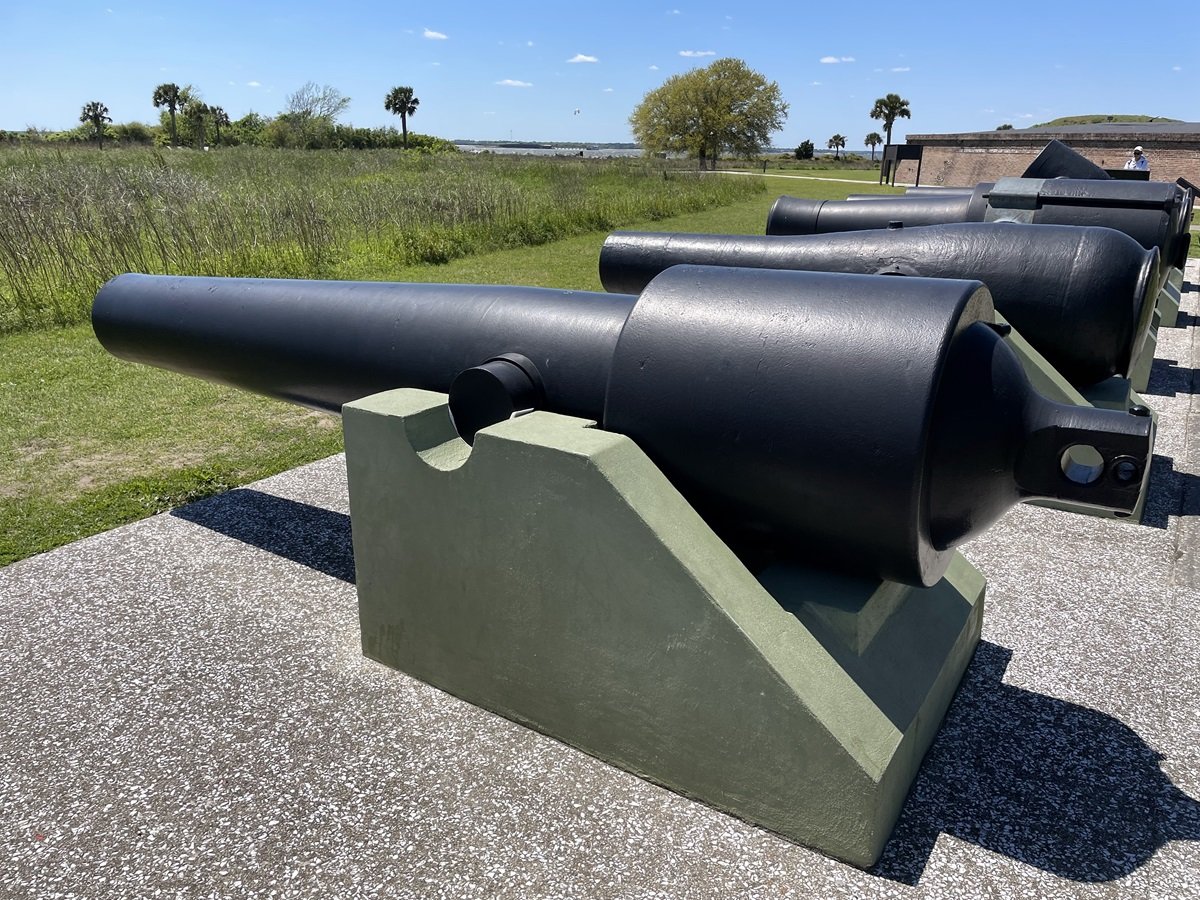
Fort Johnson in 1865
Fort Johnson, which dated to colonial times, had fired the "signal" mortar round at the beginning of the Bombardment of Fort Sumter, and which had been a major component of the defenses of Charleston harbor - especially after the reduction of Fort Sumter, was photographed in 1865. These photos, available in high resolution on the Library of Congress website, show the four heavy cannons facing the shipping channel, along with carriages, implements, projectiles, and more.

2.9-Inch Blakely Rifles at the South Carolina Military Museum
Two 2.9-Inch Blakely Rifles recovered in 1974 from the wreck of SS Georgiana are displayed at the South Carolina Military Museum in Columbia, South Carolina. Georgiana was attempting to run the blockade into Charleston on March 19th, 1863 when she was intercepted by blockading vessels including the Yacht America, USS Housatonic, and USS Wissahickon.

The Bronze Smoothbores of Charleston
Three bronze smoothbore cannons - A 6-Pounder Field Gun of the American Revolution, a Model 1841 12-Pounder Howitzer engraved S.C., and a 12-Pounder Mountain Howitzer at Fort Sumter - are displayed in Charleston, South Carolina.

10-Inch Confederate Columbiad at the South Carolina Military Museum
Bellona Foundry 10-Inch Columbiad Number 22 is displayed at the South Carolina Military Museum in Columbia, South Carolina. This Columbiad, cast in 1863, was part of the defenses of Charleston, sold for scrap after the war, lost in a shipwreck, and recovered and conserved in the 21st Century.

The 6.4-Inch Parrott Rifles of Greenville, South Carolina
Two 6.4-Inch Parrott Rifles (also called 100-Pounder Parrott Rifles) are displayed in Greenville, South Carolina beside a Confederate Monument. Despite flanking a Confederate Monument, they were produced for the US Army, and cannons with “neighboring” serial numbers are known to have been used to bombard Confederate positions near Charleston. It is possible that these two cannons saw similar service.

The Manufacture of US Navy 8-Inch Muzzle Loading Rifles from 11-Inch Dahlgren Shell Guns
An excerpt from Augustus Paul Cooke's A Text Book of Naval Ordnance and Gunnery Prepared for the Use of Cadet Midshipmen of the United States Naval Academy describes the manufacture of 8-Inch Muzzle Loading Rifles from existing 11-Inch Dahlgren Smoothbore Shell Guns. The post includes cutaway illustrations from the book and photographs from preserved Dahlgren cannons.

Early US Navy 24-Pounder in Georgetown, South Carolina
An early US Navy 24-Pounder is displayed in Joseph Rainey Park in Georgetown, South Carolina. This cannon may have been authorized by the same act of Congress which authorized USS Constitution and the other “Six Frigates”.

The Citadel’s Cannons
Displayed on the campus of The Citadel in Charleston, South Carolina are two 2.9-Inch Parrott Rifles, two Model 1841 6-Pounders, a 3.3-Inch Parrott Rifle, and a 7-Inch Brooke Rifle.

3.56-Inch Cameron Rifle at the Museum at Market Hall
A 3.56-Inch Cameron Rifle, which may have been used against gunboats of the US Navy operating along the South Carolina coast, is displayed in the Museum at Market Hall in Charleston, South Carolina.

USS Keokuk’s Dahlgren and the Rodman Carriage
The 11-Inch Dahlgren at White Point Garden near Charleston, South Carolina is mounted upon a carriage for a 10-Inch Rodman. One of the two Rodmans now on the ground at Fort Moultrie may have “donated” the carriage. Looking at the cannon and the carriage, one can see how they were used together.

10-Inch Model 1844 Columbiad, Banded and Rifled, at Fort Sumter
A 10-Inch Columbiad Model 1844 which was banded and rifled by the Confederates is displayed at Fort Sumter.

8-Inch Parrott Rifles of Forts Moultrie and Sumter
Two 8-Inch Parrott Rifles are preserved near Charleston, South Carolina. One may be found at Fort Moultrie and the other at Fort Sumter. Both were brought (along with several others of the type) in 1872 as part of modernizations to the forts. Both were buried around 1900 after they had become obsolete and it was easier to bury them than remove them.

10-Inch Confederate Columbiads at Fort Moultrie
Four 10-Inch Confederate Columbiads are on display at Fort Moultrie near Chareston, South Carolina. US Army 10-Inch Rodman guns are also present allowing the visitor to compare the two types.

8-Inch Columbiad, Model 1857, at Fort Moultrie
An 8-Inch Columbiad, Model of 1857, which was banded and rifled by the Confederates is displayed at Fort Moultrie near Charleston, South Carolina. This rare cannon is one of only two or three of the type still in existence.

10-Inch Columbiad, Model 1844, Banded and Rifled at Fort Moultrie
A 10-Inch Columbiad, Model 1844, which was rifled, banded, and equipped with a bronze trunnion band is preserved at Fort Moultrie near Charleston, South Carolina.

The 10-Inch Parrott of Fort Moultrie
Preserved at Fort Moultrie near Charleston, South Carolina is at 10-Inch Parrott Rifle.

Cannons of Fort Moultrie
Fort Moultre, on Sullivan’s Island near Charleson, South Carolina, displays two Model 1829 32-Pounders and a Model 1819 24-Pounder. Fort Moultrie, the site of a 1776 victory and much fighting during the Civil War, shows the entire history of American seacoast defense from 1776 to 1945.

The 15-Inch Rodmans of Forts Sumter and Moultrie
Four 15-Inch Rodman Columbiads (Pattern 1861) are preserved in the Charleston area at Forts Moultrie and Sumter

The Banded 12-Pounder at the Powder Magazine
Preserved outside the Powder Magazine Museum in Charleston, SC is a rifled and banded 12-pounder originally made by and for the British during the reign of George III!

Admiral Dahlgren, USS Harvest Moon, and the Columbiads of Winyah Bay
On February 28th, 1865, Admiral John Dahlgren visited a captured fort guarding Winyah Bay near Georgetown, SC. Principle among the cannons which he described were two 10-inch Columbiads. You may visit Battery White and two Columbiads which Admiral Dahlgren saw in 1865.